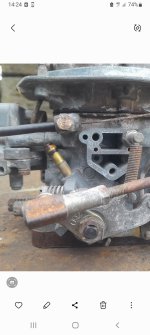Tom1991
New member
Hi... I have recently purchased a fiat 124 for restoration, I'm currently trying to get the engine running but having problems with the carb, it has a weber 34 dms fitted
See attached pic, what is this brass pipe on the carb, is it a vent? Vacuum? Or should it be blocked off.
Any info appreciated
Thanks
See attached pic, what is this brass pipe on the carb, is it a vent? Vacuum? Or should it be blocked off.
Any info appreciated
Thanks


